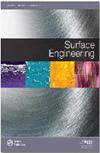Understanding the fundamentals of TiO2 surfacesPart II. Reactivity and surface chemistry of TiO2 single crystals
IF 2.6
4区 材料科学
Q3 MATERIALS SCIENCE, COATINGS & FILMS
引用次数: 0
Abstract
ABSTRACT In order to promote the application of TiO2 in surface modification technologies, a detailed understanding of its structure and properties is necessary. For this reason, the reactivity and corresponding surface chemistry of stoichiometric and non-stoichiometric single crystals of titanium dioxide have been widely studied. In Part II of this review, special attention is paid to the role of individual surface sites and the effect of available charge on the adsorption processes on stoichiometric and reduced single crystal rutile and anatase surfaces. In addition, the most appropriate surface science methods used to study the surface chemistry of these surfaces are also highlighted. An understanding of the interaction of H2O and O2 with oxide surfaces is extremely important because these adsorbates form a de facto part of the environment in all technological applications. Moreover, they play an extraordinarily important role in the processes taking place in high-performance devices in the fields of energy, environment, and health. Consequently, special consideration is given to the adsorption and dissociation processes of the most technologically important inorganic adsorbates, such as H2O and O2, on model low Miller index single crystal surfaces of titania. In addition, light-induced reactivity of TiO2 and its application is also considered. Furthermore, the engineering of TiO2 nanocrystals with well-defined facets, their unusual photocatalytic properties, and applications are also briefly considered.了解TiO2表面的基本原理第二部分。TiO2单晶的反应性和表面化学
摘要为了促进TiO2在表面改性技术中的应用,有必要详细了解其结构和性能。由于这个原因,二氧化钛的化学计量和非化学计量单晶的反应性和相应的表面化学已经被广泛研究。在本综述的第二部分中,特别注意了单个表面位点的作用以及可用电荷对化学计量和还原的单晶金红石和锐钛矿表面吸附过程的影响。此外,还强调了用于研究这些表面的表面化学的最合适的表面科学方法。了解H2O和O2与氧化物表面的相互作用是极其重要的,因为在所有技术应用中,这些吸附质实际上是环境的一部分。此外,它们在能源、环境和健康领域的高性能设备中发挥着极其重要的作用。因此,特别考虑了技术上最重要的无机吸附质,如H2O和O2,在二氧化钛的低Miller指数单晶表面上的吸附和离解过程。此外,还考虑了TiO2的光致反应性及其应用。此外,还简要考虑了具有明确晶面的TiO2纳米晶体的工程、其不同寻常的光催化性能和应用。
本文章由计算机程序翻译,如有差异,请以英文原文为准。
求助全文
约1分钟内获得全文
求助全文
来源期刊

Surface Engineering
工程技术-材料科学:膜
CiteScore
5.60
自引率
14.30%
发文量
51
审稿时长
2.3 months
期刊介绍:
Surface Engineering provides a forum for the publication of refereed material on both the theory and practice of this important enabling technology, embracing science, technology and engineering. Coverage includes design, surface modification technologies and process control, and the characterisation and properties of the final system or component, including quality control and non-destructive examination.
 求助内容:
求助内容: 应助结果提醒方式:
应助结果提醒方式:


